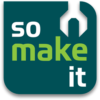Please refer to the manual for this tool, and read the Risk Assessment Below

| Date of Assessment | 01/10/21 | Version | 1.0 |
| Activity | Cutting wood or plastic on the table saw | ||
| Equipment | Table Saw | ||
| Details of activity | |||
| Induction / Role Required | Workshop induction | ||
| Form completed by | Chris Nash |
- This risk assessment is intended to provide guidance on the risk associated with the above equipment and activities in normal use.
- Please also check general risk assessments for the area within which this equipment or activity is based.
- Any discrepancies, errors or concerns should be raised with the document authors, area specialists (e.g. admins, superusers) or trustees.
Understanding Risk Rating:
| Risk Rating | Action |
| LOW | Ensure current control measures are in place and continue with activity |
| MED | Control measures may be adequate, co-supervision is recommended |
| HIGH | Do not undertake activity without further consultation with area specialists |
Risk Assessment
| Identify Hazards | Who may be harmed and how | Severity | Control Measures | Likelihood | Risk Rating |
| Something with the potential to cause harm | Users, bystanders or particular at risk groups | Low / Medium / High | What is in place to reduce the harm or likelihood. | Low / Medium / High | |
| Incompetent user | User, Bystander | HIGH | Users must not use tools that they are not competent to use. Members must challenge use that they believe is dangerous. Users should read the user manual where applicable. Users must read the risk assessment before using a tool. Users will be advised during induction which tools they will need supervision or an induction to use. | LOW | MED |
| Contact with blade | User | HIGH | Do not remove guard under any circumstances. Ensure the riving knife is in place before use Do not put hands into exclusion zone (within 30cm of blade). Use push sticks and the fence provided when making cuts. Do not move hands past the blade. Do not lean over the blade. Saw should be switched off immediately after use. Saw blade should stop within 10 seconds of being turned off. | LOW | MED |
| Drawing in (being pulled into the saw) | User of the tool | HIGH | User of the saw should not wear gloves, ties, scarves, or other long flowy clothing that could get pulled into the blade. Do not put hands into exclusion zone (within 30cm of blade). Do not lean over blade | LOW | MED |
| Ejection of workpiece (Kickback) | User of the tool, users of the room, the space. | HIGH | Do not stand directly behind blade. Use a feather board when working with smaller pieces. Take care to keep the workpiece against the fence when making mitre cuts Ensure riving knife is in place | LOW | MED |
| Dust (inhalation, fire, explosion) | User of the tool, users of the room, the space. | LOW | The saw should be used with the dust extractor attached and working. Maintenance must include the cleaning of dust from within the saw housing. A respirator or mask should be used whilst operating this tool for prolonged periods | LOW | LOW |
| Blade snatching or jamming | User, bystanders | MED | Only cut wood and plastic on the table saw Ensure a visual inspection of the table saw is undertaken before every use to check for physical obstructions | LOW | LOW |
| Noise | User of the tool, users of the room. | LOW | Ear protection is advised. | LOW | LOW |
| Flying splinters | User of the tool, users of the room. | LOW | Eye protection must be worn whilst using the table saw Eye protection must be worn by all users of the workshop. Do not cut small pieces | LOW | LOW |
